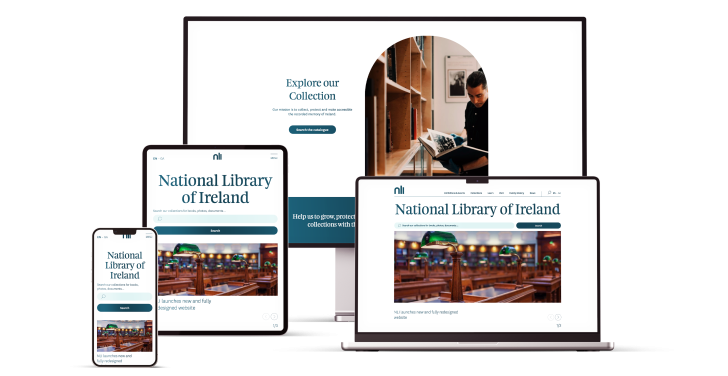Annertech and the digital world: How things have changed over 15 years
As Annertech turns 15, its directors and longest-serving employees reflect on how the industry has changed – and how this tech-savvy digital agency has had to adapt.
When Annertech was formed in 2008, there were 1.46 million internet users. Today, there are 5.19 billion. Smartphones were just getting started – making up just 13 percent of the overall handset market.
Apple was still at the top of its game, introducing 3G Internet access and GPS to its second-generation iPhone and Google’s Android made its debut. Not to mention other hot innovations like “2008’s biggest success stories: netbooks”, as well as affordable Blu-Ray Players. Internet Explorer 7 was still a thing.
Since then there have been many changes and improvements. Lightning-fast internet access is the norm. Streaming services have taken over where Blu-Ray Players left off. In-person customer service centres were trimmed as digital services expanded.
All of these tech advances, especially when it comes to the pocket rockets that most people use to browse the internet these days, have played a role in the way that websites have evolved. And, being at the centre of this digital world, Annertech has evolved too.
Annertech changes
In those early days Annertech had two team members – co-founders Stella Power and Dermot Frost – but today it is classified as a “large agency”, with two branches: in Ireland and the UK.
The Annertech team works with (and on) some of the best software in the world, which enables it to offer its clients the best tech available. Annertechies primarily work with open source software, including the Drupal CMS, and offer services such as website design, development and maintenance; content, SEO and digital marketing; and technology solutions and strategy.
And thanks to the internet and digital connections the team is able to be spread across Europe (and beyond), keeping in touch with each other and with clients using tools like Microsoft Teams, Zoom, emails and Trello.
At least once a year, team members get together in person. It’s usually around the annual Drupal conference, called DrupalCon. One or two days are set aside for Annertech Day, where discussions ensue around Annertech, the industry and ways to work better.
Things have changed at Annertech since developer Gavin Hughes joined in 2013.
“In my early days Annertech was very much the place for NGOs. We had non-profit organisations like The Wheel, Trócaire and Oxfam along with the likes of the Local Government Management Agency and Galway-Mayo Institute of Technology (now part of the Atlantic Technological University).
“Although we were working with some big projects they would be mostly well-known in Ireland and to a lesser extent in the UK, although I remember the National Maritime Museum in Greenwich! Since then there has been a larger and more diverse range of clients with a global presence – the likes of Glanbia, Paragon and Médecins Sans Frontières.”
Industry changes
Platforms like Drupal
It’s not just Annertech that has changed over the years. Drupal itself has grown and improved.
2008 was the year when Drupal 6 was released. The latest version of Drupal is Drupal 10, which was released last year.

“Drupal is no longer a hobby project for small sites - it’s proper Enterprise level software,” said Director of Technology Alan Burke. He joined Annertech in 2010 as director and a frontend developer, and was Stella’s first employee hire.
Alan’s area of expertise is website performance, and he’s seen first-hand how fast websites load, and how evolved they have become.
Part of this is due to Drupal, which is known for being high-performing, reliable and has excellent security. Today, Drupal is used by many government agencies in the United States, London and Europe; media companies like BBC, NBC and MTV UK; organisations like Amnesty International; and universities like the University of Oxford, University of Limerick and the Atlantic Technological University.
Tech influences
The development of mobile phones influenced one of the biggest changes to the industry – websites had to adapt quickly from being computer-focused to being mobile friendly.
“In 2008, most web browsing was still on desktop, so that’s been a big change,” said Dermot.
“This was in the days when I actually used to work with CSS,” added Stella. “I wasn’t any good at it, mind, but felt comfortable enough with it. Then mobile devices took off and implementing designs for the different browsers and devices was suddenly a lot more complicated!”

Today, websites are built to be responsive, no matter which device a user is using to access that website.
By the time Director of Development Mark Conroy joined Annertech as a frontend developer in 2013, the mobile movement had been firmly established, and organisations were scrambling to make sure their websites were suited to smaller screens.
In fact, Mark’s first task was to make the Irish Cancer Society website mobile friendly.
“The Cancer Society’s website had been designed at a time before the term responsive web design was invented. As ever, retrofitting a new feature/approach is more tricky than something that is planned from the start,” he said.
And new features are being added to websites every day, as organisations try to offer more services online.
“Functionality has improved immensely over the years. When we started most websites were about publishing information, whereas now there’s a lot more in the way of interactivity and service provision,” said Dermot.
Inclusivity matters
Although the world Wide Web wasn’t designed with universality in mind, its founder, Tim Berners-Lee is at the forefront of a movement to “decentralise” the web.
“The power of the web is in its universality. Access by everyone regardless of disability is an essential aspect.” Berners-Lee said.
The drive to make the web more inclusive has been ongoing since the mid-1990s, but it really ramped up with the introduction of Web Content Accessibility Guidelines in 1999. Standards have improved dramatically with every new version of these guidelines, and the WCAG2.2 proposed recommendation as of 20 July 2023 is soon to be the standard.
“One very positive change has been a drive towards accessibility over the past couple of years. We've been striving to make all our websites as accessible as possible since the beginning. It's been great to see accessibility now being seen as a necessary part of web design now, rather than something you try to add on at the end,” said Mark.
Annertech now has accessibility champions within the team, who ensure that clients' websites are as accessible as they can possibly be, and a concerted effort has been made to add accessibility to the beginning stages of every project.

Tom Bamford is at the forefront of Annertech's drive to make the web more accessible to everybody. You can read our Meet the Team blog about him to find out why he's so passionate about accessibility.
“The other big change is just how people now think about the web and the web design and development process,” said Stella.
“In the early days desktop was king and virtually no one cared about mobile or website accessibility or the user experience or even data security. These days everyone is much more aware of the implications of not caring about these and they are central to every project we deliver.”
As the internet has grown and adapted, so have the people who work within it.
“In terms of our day-to-day work I would say that specialisation is probably the most noticeable aspect of change,” said Mike King, Director of Delivery.
“Over the years roles have tended to become T-shaped rather than E-shaped, meaning people have a single topic in which they have a deep understanding, rather than multiple knowledge pools.”
Conclusion
Although many aspects of the digital world have changed in the last 15 years, some things have remained the same.
“We still help people solve problems and we still have to deal with all sorts of problems, be they technical, process, or human in nature,“ said Anthony Lindsay, Director of Managed Services.
“The technology evolves and we as a group are becoming more competent as we continue to pick up skills and experience.”
Want to move to an agency that stays abreast of change?
We pride ourselves on being agile and flexible, and our solutions-focused approach to challenges ensures that we stay up to date with technology - pioneering innovative solutions to many of our clients’ problems. Does this sound like an agency you’d like to work with?

Alison Visser Head of Content
After more than two decades in journalism, Alison now collaborates with Annertech's clients to ensure that their content is the best it possibly can be.